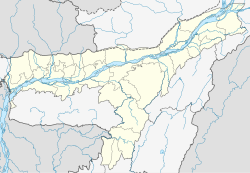Goalpara
| Goalpara | |
|---|---|
| city | |
| Location in Assam, India | |
| Coordinates: 26°10′N 90°37′E / 26.17°N 90.62°ECoordinates: 26°10′N 90°37′E / 26.17°N 90.62°E | |
| Country |
|
| State | Assam |
| District | Goalpara |
| Government | |
| • Body | Goalpara Municipality Board |
| Elevation | 35 m (115 ft) |
| Population (2001) | |
| • Total | 48,911 |
| Languages | |
| • Official | Assamese |
| Time zone | IST (UTC+5:30) |
| PIN | 783101 |
| ISO 3166 code | IN-AS |
| Vehicle registration | AS-18 |
| Website | goalpara |
Goalpara (Pron: /ɡoʊɑːlˈpɑːrə/ (Assamese: গোৱালপাৰা) is the district headquarters of Goalpara district, Assam, India. It is situated 134 kilometres (83 mi) to the west of Guwahati.
The name Goalpara is said to have originated from the word "Gwaltippika" meaning Guwali village, or The village of the milk men. In local dialect, "para" means village.
Goalpara is located on the bank of the river Brahmaputra. Goalpara Kingdom was being ruled by KochRajbongshi Kings. It has an average elevation of 35 metres (114 feet).
Goalpara is endowed with scenic beauty. Hulukanda Hill, located at the heart of Goalpara on the bank of the Brahmaputra river, is one of the natural scenic views in the town, with various kinds of waterfowl and monkeys. There are some other bodies of water such as Hashila beel and Kumri beel. The evergreen forests on low hills create an undulating landscape. People of goalpara speak rajbongshi language, it is also known as goalpariya language.
Goalpara district consists of 8 blocks:
As of 2001[update] India census, Goalpara had a population of 48,911. Males constituted 52% of the population and females 48%. Goalpara had an average literacy rate of 69%, higher than the national average of 59.5%. Male literacy rate is 73% and female literacy rate is 64%. In Goalpara, 12% of the population is under 6 years of age.
Muslims constitute the majority of population in Goalpara. Most residents of Goalpara refer to themselves as "deshi" (of the local region) in order to avoid addressing this issue directly. Goalpariya dialect is widely spoken by the residents and the most spoken language in the area. It was once a princely state ruled by the Rajbongshi/Koch Rajbongshi kings.
...
Wikipedia


